Discover 20 hidden attractions, cool sights, and unusual things to do in Pushkin (Russia). Don't miss out on these must-see attractions: Amber Room, Alexander Palace, and Catherine Park. Also, be sure to include Catherine Palace in your itinerary.
Below, you can find the list of the most amazing places you should visit in Pushkin (City of St. Petersburg).
Table of Contents
Amber Room
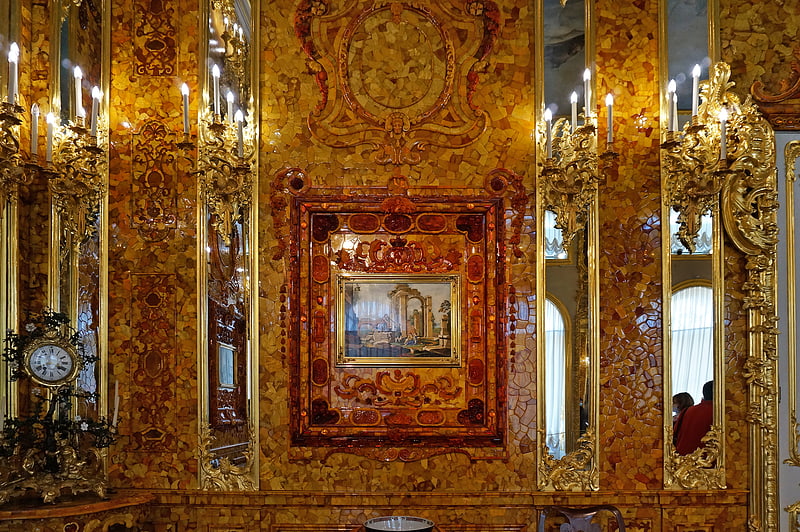
Also known as: Янтарная комната
Reconstruction of the historic mosaics. The Amber Room was a chamber decorated in amber panels backed with gold leaf and mirrors, located in the Catherine Palace of Tsarskoye Selo near Saint Petersburg.
Constructed in the 18th century in Prussia, the room was dismantled and eventually disappeared during World War II. Before its loss, it was considered an "Eighth Wonder of the World". A reconstruction was made, starting in 1979 and completed and installed in the Catherine Palace in 2003.
The Amber Room was intended in 1701 for the Charlottenburg Palace, in Berlin, Prussia, but was eventually installed at the Berlin City Palace. It was designed by German baroque sculptor Andreas Schlüter and Danish amber craftsman Gottfried Wolfram. Schlüter and Wolfram worked on the room until 1707, when work was continued by amber masters Gottfried Turau and Ernst Schacht from Danzig (Gdańsk).
It remained in Berlin until 1716, when it was given by the Prussian King Frederick William I to his ally Tsar Peter the Great of the Russian Empire. In Russia, the room was installed in the Catherine Palace. After expansion and several renovations, it covered more than 55 square metres (590 sq ft) and contained over 6 tonnes (13,000 lb) of amber.
The Amber Room was looted during World War II by the Army Group North of Nazi Germany, and taken to Königsberg for reconstruction and display. Some time in early 1944, with Allied forces closing in on Germany, the room was disassembled and crated for storage in the Castle basement. Konigsberg was destroyed by allied bombers in August 1944 and documentation of the room location ends there. Its eventual fate and current whereabouts, if it survives, remain a mystery. In 1979 the decision was taken to create a reconstructed Amber Room at the Catherine Palace in Pushkin. After decades of work by Russian craftsmen and donations from Germany, it was completed and inaugurated in 2003.[1]
Address: Екатерининский дворец, Pushkin
Alexander Palace
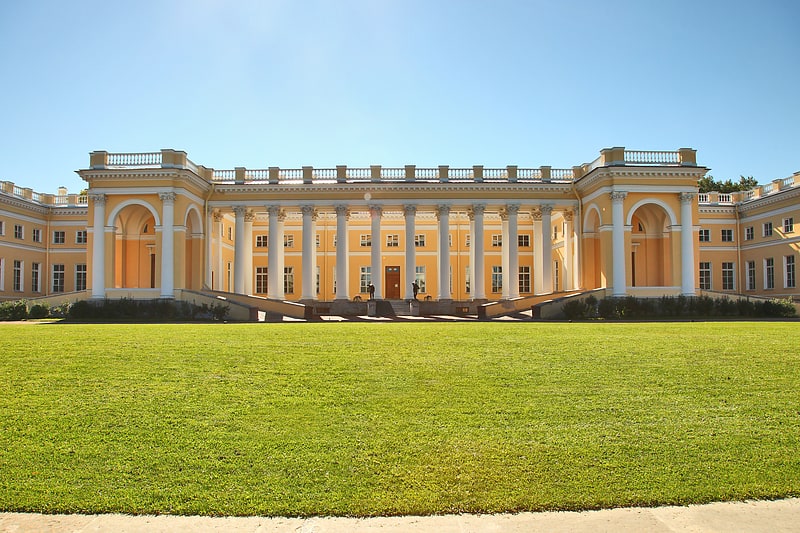
Also known as: Александровский дворец
Imperial residence in Saint Petersburg, Russia. Alexander Palace is a former imperial residence near the town of Tsarskoye Selo in Russia, on a plateau about 30 miles south of Saint Petersburg. The Palace was commissioned by Empress/Tsarina Catherine II in 1792.
Due to the privacy it offered, when officially resident in St Petersburg, Alexander Palace was the preferred residence of the last Russian Emperor, Nicholas II and his family. Its safety and seclusion compared favourably to the Winter Palace during the years immediately prior to the Russian Revolution. In 1917, the palace became the family’s initial place of imprisonment after the first of two Russian Revolutions in February which overthrew the House of Romanov during World War I. Alexander Palace is situated in Alexander Park, not far from Catherine Park and the larger, more elaborate Catherine Palace. After undergoing years of renovation, Alexander Palace opened in Summer 2021 as a state museum housing relics of the former imperial dynasty.[2]
Address: Sadovay str, 2, 196601 Pushkin
Catherine Park
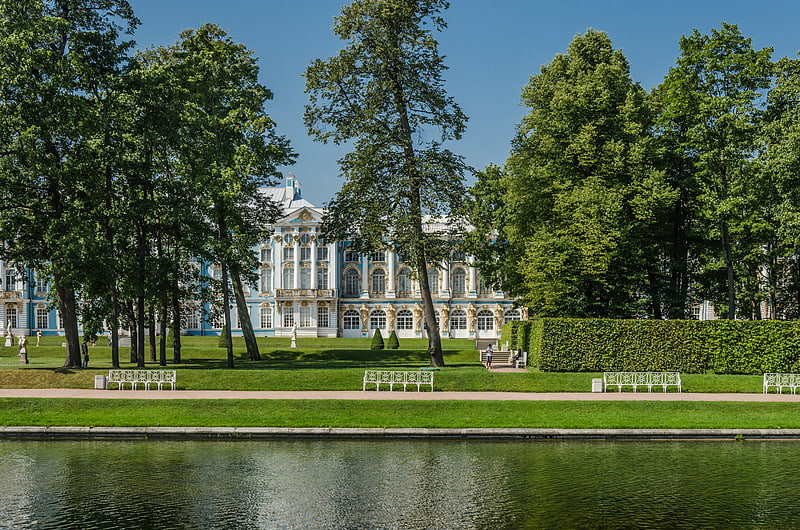
Also known as: Екатерининский парк
Park in Saint Petersburg, Russia. The Catherine Park is the large landscaped area to the south of the Catherine Palace, located in the town of Tsarskoye Selo, 25 km south-east of St. Petersburg, Russia.
The park has two parts: a formal 18th century Dutch-style garden and a natural English garden.[3]
Address: Garden St, 7, 196601 Pushkin
Catherine Palace
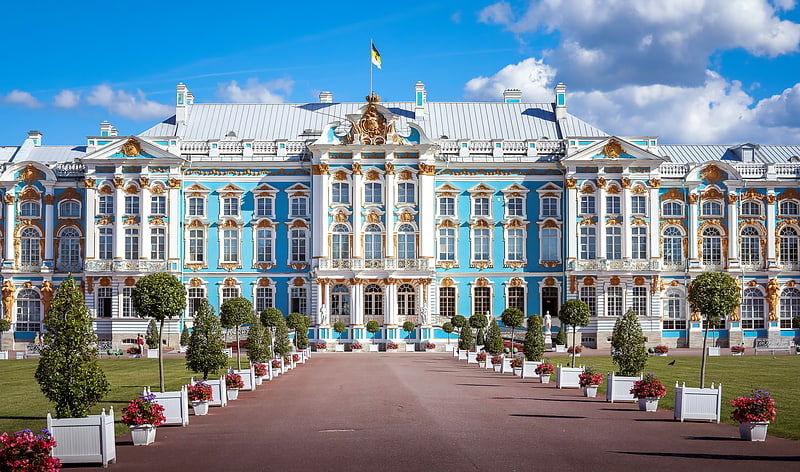
Also known as: Большой Екатерининский дворец
Museum in Saint Petersburg, Russia. The Catherine Palace is a Rococo palace in Tsarskoye Selo, 30 km south of St. Petersburg, Russia. It was the summer residence of the Russian tsars. The Palace is part of the World Heritage Site Saint Petersburg and Related Groups of Monuments.[4]
Address: Garden St, 7, 196601 Pushkin
Ratnaya Palata
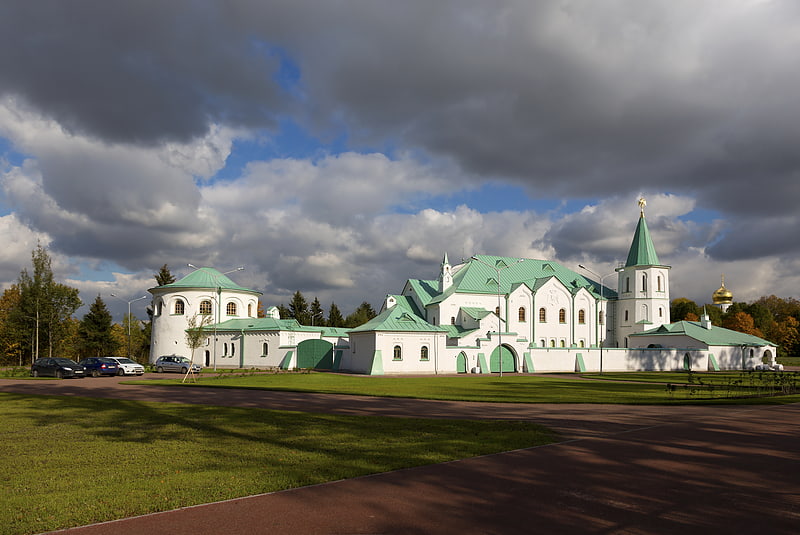
Museum in Saint Petersburg, Russia. Ratnaya Palata is Russia's World War I museum building in Pushkin town near Saint Petersburg, Russia. Designed for Romanov royal dynasty's 300th anniversary in Russian Revival architecture style together with the buildings of the church campus of the Sovereign's Cathedral of the Icon of Our Lady of Saint Theodore and the private royal railway terminal. Suggested, not long before World War I, to be built as a museum of Russian war history, based on Elena Tretyakova's collection gift, the exhibition content, when the war was already under way in 1915, was focused by Emperor Nicholas II on then current heroic deeds of Russian warriors, but the display, at first shown in the St Petersburg Admiralty building, opened in Martial Chamber for only a short time before the end of Russian Empire in February 1917, and was closed down a year later by Soviet authorities. Having been used after that for unrelated purposes, the Martial Chamber building was legally transferred to the Tsarskoye Selo Museum complex in 2008 and was cleared, restored, given a new collection of exhibits and reopened as modern Russia's first museum of World War I by the centennial of its beginning in August 2014. The exhibition is titled "Russia in the Great War" after a name for the war used at the time of its battles.[5]
Tsarskoye Selo Lyceum

Also known as: Императорский Царскосельский лицей
Building. The Imperial Lyceum in Tsarskoye Selo near Saint Petersburg, also known historically as the Imperial Alexander Lyceum after its founder Tsar Alexander I, was an educational institution which was founded in 1811 with the object of educating youths of the best families who would afterwards occupy important posts in the Imperial service.
Its regulations were published on 11 January 1811, but they had received the Imperial sanction on 12 August 1810, when the four-story "new" wing of the Great Palace was appointed for its accommodation, with special premises for a hospital, a kitchen and other domestic requirements, as well as a residence for the administrative staff. Furniture and utensils were given together with the Neoclassical building, designed by Vasily Stasov, next to the Catherine Palace.
The Tsarskoye Selo Lyceum was opened on 19 October 1811. The first graduates included Alexander Pushkin and Alexander Gorchakov. The opening date was celebrated each year with carousals and revels, and Pushkin composed new verses for each of those occasions. In January 1844 the Lyceum was moved to St Petersburg.
During the 33 years of the Tsarskoye Selo Lyceum's existence, there were 286 graduates. The most famous of these, in addition to the above two, were Anton Delvig, Wilhelm Kuchelbecker, Nicholas de Giers, Dmitry Tolstoy, Yakov Grot, Nikolay Danilevsky, Aleksey Lobanov-Rostovsky, Fyodor Shcherbatskoy and Mikhail Saltykov-Shchedrin.[6]
Address: Garden St, 7, 196601 Pushkin
Tsarskoye Selo
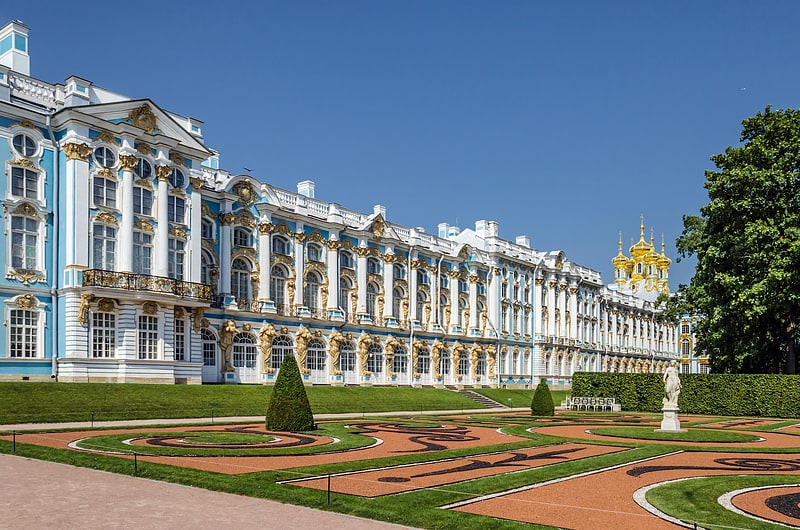
Also known as: Царское Село
Historical place museum in Russia. Tsarskoye Selo was the town containing a former residence of the Russian imperial family and visiting nobility, located 24 kilometers south from the center of Saint Petersburg. The residence now forms part of the town of Pushkin. Tsarskoye Selo forms one of the World Heritage Site Saint Petersburg and Related Groups of Monuments.
The town bore the name Tsarskoe Selo until 1918, Detskoe Selo between in the years 1918–1937, then Pushkin from 1937 onwards.[7]
Alexander Park
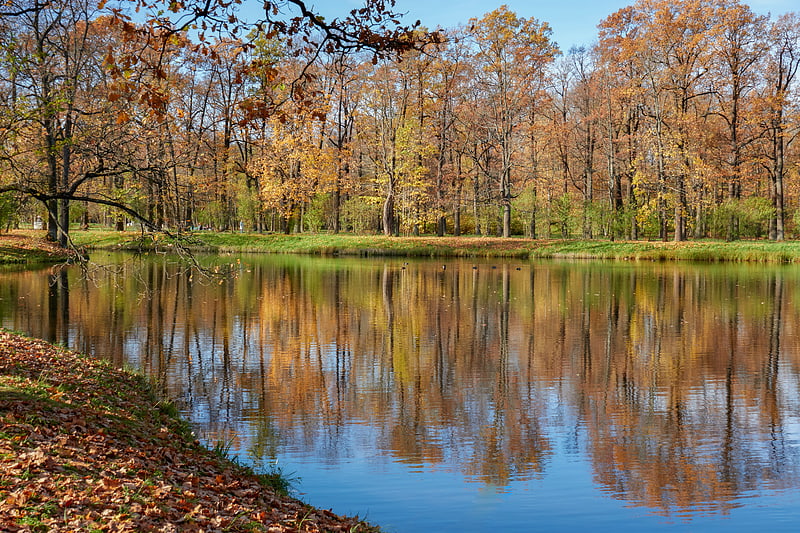
Also known as: Александровский парк
Park in Saint Petersburg, Russia. Alexander Park is a park in Tsarskoye Selo outside St. Petersburg.[8]
Address: Dvortzovaya St., 2, 196601 Pushkin
Chesme Column
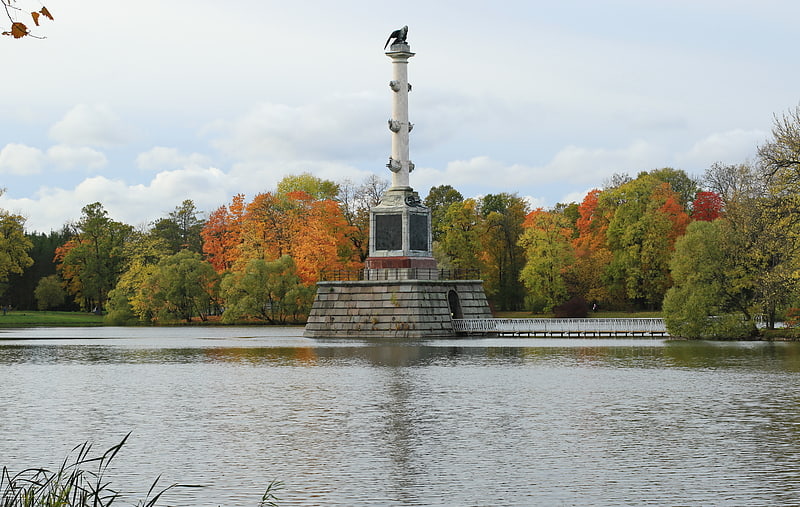
Also known as: Чесменская колонна
Tourist attraction in Russia. The Chesme Column is a rostral column in the Catherine Park at the Catherine Palace, a former Russian royal residence at Tsarskoye Selo, a suburb of Saint Petersburg. The column commemorates three Russian naval victories in the 1768–1774 Russo-Turkish War: the Battle of Chios, the Battle of Chesma and the Battle of Mytilene. It was constructed from 1774 to 1778 in the large pond of the landscape park of the Catherine Palace to Antonio Rinaldi's designs.
The monument is a Doric rostral column made from three pieces of white-and-pink marble; this raspberry quartzite was quarried in Karelia, at the villages of Shyoltozero, Shoksha, and Rybreka, the only place in the world where it was commercially mined. The column is decorated with the rostra of three ships' bows, and crowned by a bronze figure of an eagle (a symbol of Russia) crushing a crescent (a symbol of Turkey). The column stands on a grey marble pedestal, on three sides of which are bronze bas-reliefs illustrating the Russian victories, while the fourth side is inscribed with a description of the battles. The bas-reliefs were destroyed by the Germans during World War II, and subsequently replaced using old photographs. The column was reopened in June 1996, commemorating the 300th anniversary of the Russian Navy. The pedestal rests on a stepped pyramid-like granite platform, with an arched opening with a grille leading to a flight of steps providing access to the pedestal.[9]
Address: Екатерининский парк, Pushkin
Babolovo Palace

Also known as: Баболовский дворец
Dacha in Saint Petersburg, Russia. Babolovo or Babolovka was a dacha of Prince Potemkin in Tsarskoe Selo.
It was in 1780 that Catherine II of Russia presented the grounds adjoining the Catherine Park and the Alexander Park to her then-favourite, Potemkin. A temporary wooden palace was built to house the lovers' trysts. It was rebuilt in stone to a Gothic Revival design by Ilya Neyelov between 1782 and 1785. The Babolovsky Palace was essentially a summerhouse with seven rooms giving on to a park, a quaint octagonal tower and no second floor.
Alexander I of Russia used the palace for his furtive rendezvous with Sophia Velho, a court banker's daughter. He commissioned Vasily Stasov to redesign the palace. The tower was replaced with a huge bath hewn from a red granite monolith. Engineer Agustín de Betancourt had it placed within the room before the walls were constructed. The bath weighed 48 tons and was 196 cm high.
The palace fell into disrepair after the Russian Revolution and currently stands in ruins. The granite bath mentioned in one of Pushkin's first poems is still in situ. Other structures in the Babolovsky Park (which covers some 300 ha) have disappeared, apart from an aqueduct from the 1770s and Adam Menelaws' gate separating the two parks.[10]
Kagul Obelisk
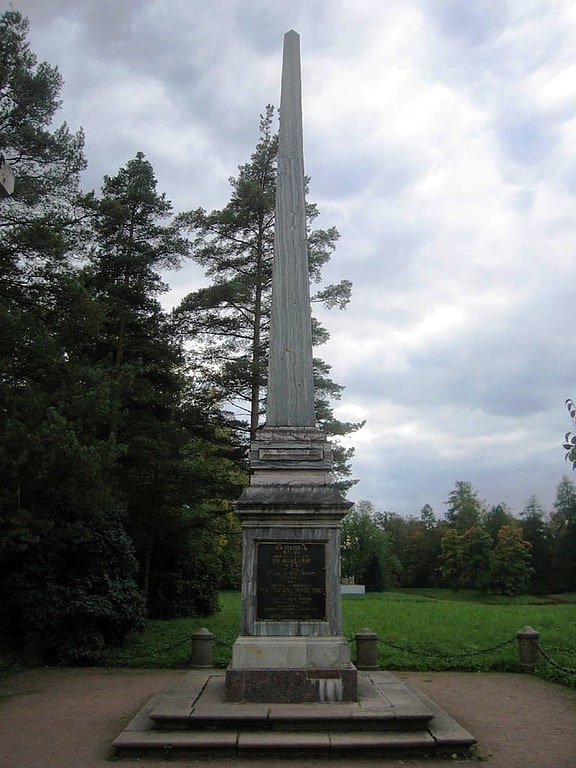
Also known as: Кагульский обелиск
Tourist attraction in Saint Petersburg, Russia. The Kagul Obelisk in Tsarskoye Selo is one of several such structures erected on behest of Catherine II of Russia in 1772 to commemorate Pyotr Rumyantsev's victory in the Battle of Kagul. Designed by Antonio Rinaldi, the dark grey-and-red marble obelisk stands in the landscape park of the Catherine Palace.
The inscription on the pedestal reads: "In memory of the victory at the Kagul River in Moldavia, July 21, 1770, under the command of Count Peter Rumyantsev the Russian army of seventeen thousand caused the Turkish Vizier Galil-Bey and his army of one hundred thousand and a half to flee to the Danube".[11]
Kanobbio House

Mansion. Kanobbio House is a historical mansion in Pushkin, Saint Petersburg. It was constructed in 1815. The house is an object of the cultural heritage of the federal significance. It is located on 18 Leontyevskaya Street.[12]
Sophia Cathedral
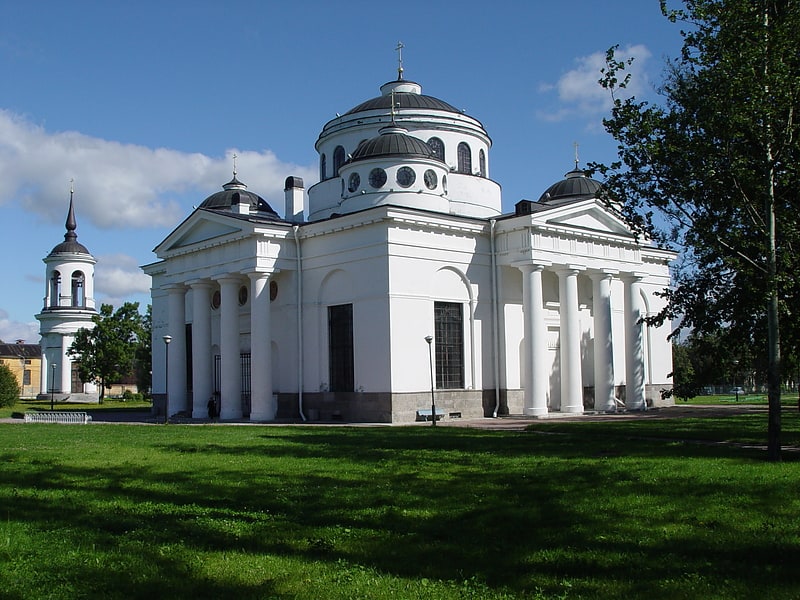
Also known as: Софийский собор
Cathedral in Saint Petersburg, Russia. The Ascension Cathedral in the town of Sophia in the vicinity of Saint Petersburg, was one of the first purely Palladian churches to be built in Russia. Rather paradoxically, it may also be defined as "the first example of Byzantinism in Russian architecture".[13]
Address: 1 Софийская площадь, Pushkin
Chinese Village
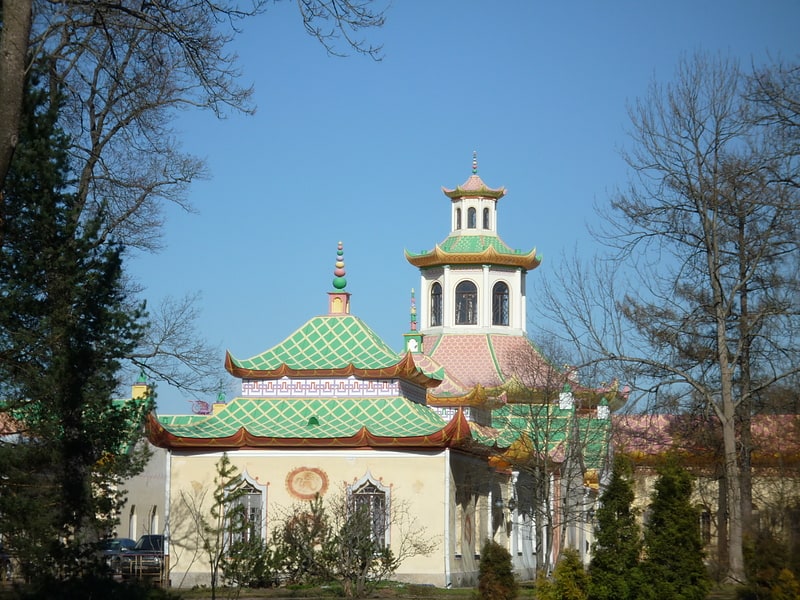
Also known as: Китайская деревня
The Chinese Village in the Alexander Park of Tsarskoye Selo, Russia was Catherine the Great's attempt to follow the 18th-century fashion for the Chinoiserie.
Probably inspired by a similar project in Drottningholm, Catherine ordered Antonio Rinaldi and Charles Cameron to model the village after a contemporary Chinese engraving from her personal collection. The village was to consist of 18 stylized Chinese houses (only ten were completed), dominated by an octagonal domed observatory (never completed at all). After Catherine failed in her ambition to procure a genuine Chinese architect, the Russian ambassador in London was instructed to obtain a replica of William Chambers's Great Pagoda in the Royal Botanic Gardens, Kew for Tsarskoye Selo, a central structure of the Chinoiserie architecture.
Catherine's death in 1796 led to the works being suspended. It was not until 1818 that Alexander I of Russia asked Vasily Stasov to overhaul the village in order to provide accommodation for his guests. Although much of the original orientalizing decor was lost as a result, the renovated village provided habitation for such eminent visitors as Nikolai Karamzin who worked on his History of the Russian State in one of the houses between 1822 and 1825.
The Chinese Opera Theatre was constructed not far from the village in 1779. It was there that an Italian composer Giovanni Paisiello would present his new operas to the Russian empress. The première of Leo Tolstoy's The Fruits of Enlightenment was also produced there. The theatre was burnt to the ground on 15 September 1941 and has never been rebuilt.
Three remarkable bridges lead to the village. The Dragon Bridge, so named after four zinc figures of winged dragons, and the Large Chinese Bridge, noted for pink granite vases and imitation coral branches, were completed in 1785. The Cross-Shaped Bridge had been constructed by the Neyelov Brothers six years earlier (illustrated, to the right).
The village was renovated under the direction of Ippolit Monighetti in 1859-61. The cottages sustained serious damage during the Nazi occupation but were restored in the 1990s to provide lodgings for VIP guests.[14]
St. John the Baptist Church
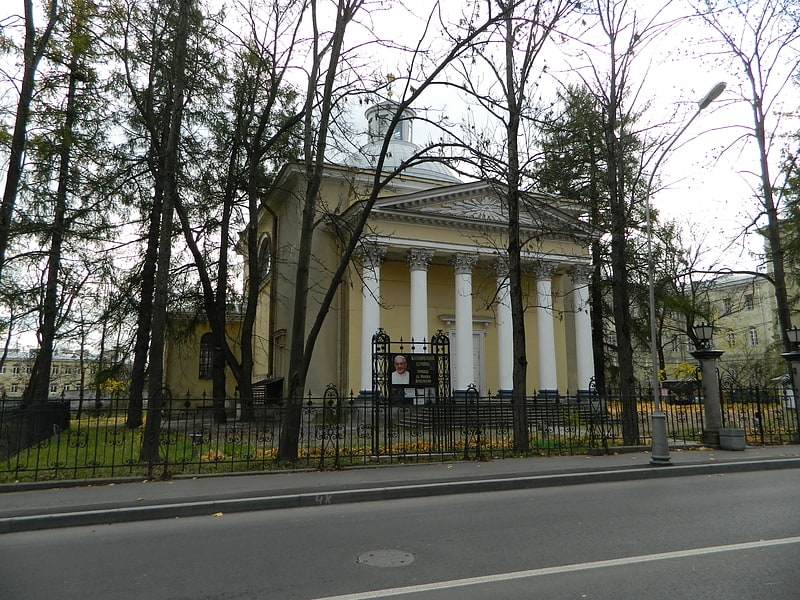
Also known as: Церковь Иоанна Крестителя
Catholic church in Saint Petersburg, Russia. St. John the Baptist Church is a Catholic church located in Pushkin, administratively part of the federal city of Saint Petersburg, Russia. It is part of the Roman Catholic Archdiocese of Moscow, in its northwestern deanery.
The first Catholic church in the imperial residence at Tsarskoye Selo was built in 1811, on the property of the master of ceremonies of the court (Ceremoniemeister), Commander Mezonyaev; but the church was not sufficient for the needs of the community. Emperor Alexander I authorized the construction of a new church on land he donated for the purpose. It was built in the neoclassical style between 1823 and 1825 by Leone and Domenico Adamini, with the assistance of Vasily Stasov. The foundation stone was blessed on 6 July 1825, the Nativity of Saint John the Baptist, in the presence of the Minister of Education. The church was consecrated by the Bishop of Minsk, Matvey Lipsky, on 4 December 1826.
The church was closed in April 1938 and became a gym. Those buried in the crypt were reburied in the cemetery of Our Lady of Kazan in Pushkin.
The church was damaged during the German occupation of the city during the siege of Leningrad. The first Catholic ceremony was held on 17 March 1991, in the presence of seven Catholic parishioners. The Mass was held the following Sunday. On 1 October 1997, the church was officially returned to the Catholic parish of the city, with an agreement with the directorate of the Tsarskoye Selo State Museum of Fine Arts on the joint use of the building.
Today the church is served by two Spanish priests.[15]
Address: 15 Дворцовая улица, Pushkin
Egyptian Gate of Tsarskoye Selo
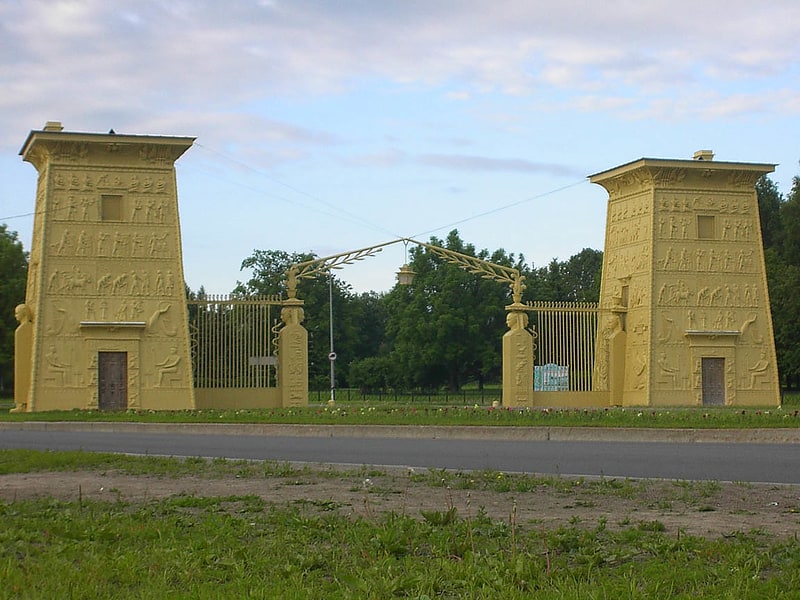
Also known as: Египетские ворота
Tourist attraction in Russia. The Egyptian Gate of Tsarskoye Selo was built in 1829 to replace the old toll-bar, which had been made redundant by the expansion of Tsarskoe Selo.
The gate, which exemplifies the Egyptian Revival style, was designed by Adam Menelaws, who was inspired by the Temple of Khonsu gates. The hieroglyphs were modeled by the professor Demut-Malinovsky. The iron gate and the cast iron columns and plates, covered with hieroglyphs, were cast in St. Petersburg at the Alexander Iron Works. The Alexander Park extended to this gate until 1895, when part of it was used for the building of barracks.
The large scale pylonesque is made of brick on one side and cast iron reliefs on the other. The drawings on the gates are carved and polished.
The style seen in the Egyptian Gates was very typical of that time. Due to the French expeditions in Egypt, the world became more interested in ancient Egyptian architecture. The hieroglyphs on the gate were included in part to show that the Russians were interested in supporting the scholars that were researching the language.[16]
Address: Петербургское ш., 196607 Пушкин
Ruin Tower
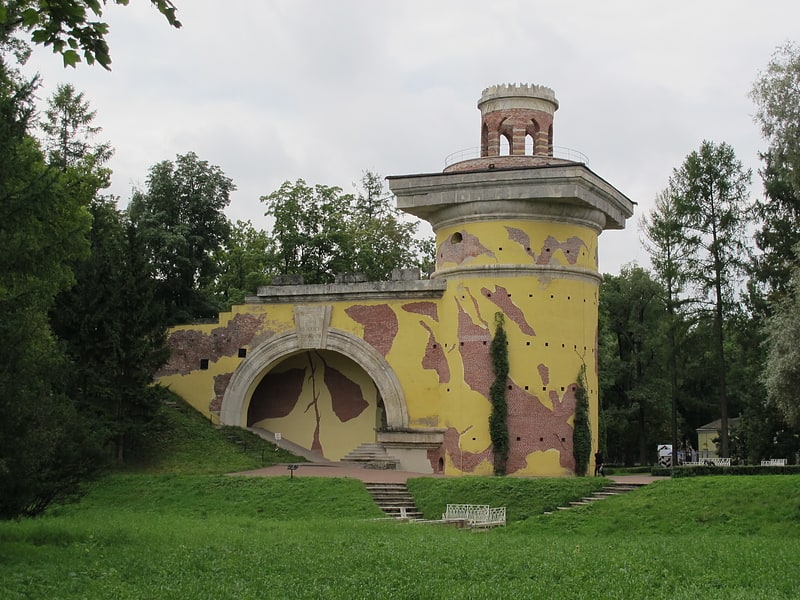
Tower in Saint Petersburg, Russia. The Ruin Tower is an 18th-century monument in Ekaterininsky Park of Tsarskoye Selo - now Pushkin, a suburban town in eponymous borough of St. Petersburg, Russia. It was designed and constructed in 1771-1773 by German-Russian architect Yury Felten.[17]
Large Chinese Bridge
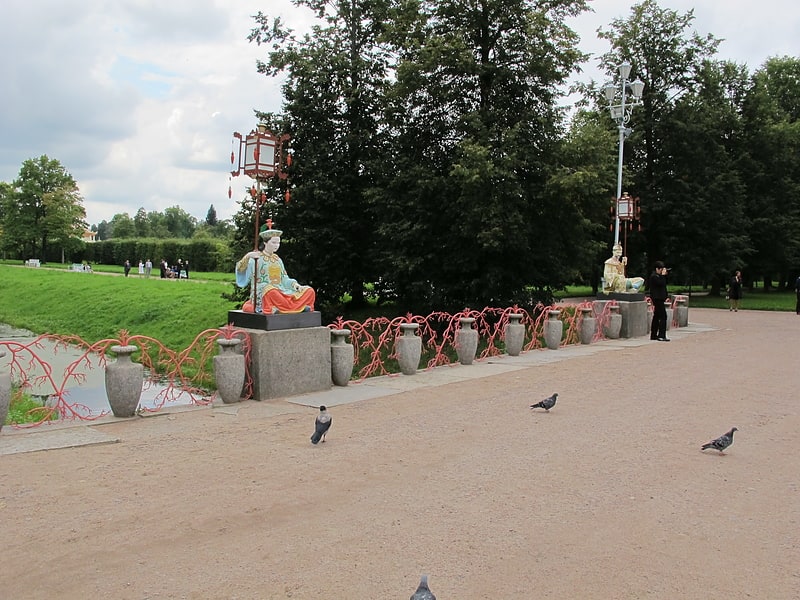
Also known as: Александровский парк #Большой китайский мост
Bridge. The Large Chinese Bridge is a small bridge over the Krestovy Channel located in the Chinese Village in the Alexander Park of Tsarskoye Selo 25 km south of the centre of St. Petersburg. The bridge is located near the Chinese Theater, opposite the central gates of the Catherine Palace. It is one of the entrances to Alexander Park. The bridge is named Large so to distinguish it from two Small Chinese Bridges located in the park.
The Large Chinese Bridge was commissioned by Catherine the Great as part of her plan to create a Chinoiserie in her park. Catherine ordered Antonio Rinaldi and Charles Cameron to model the village after a Chinese engraving from her personal collection. The village was expected to consist of 18 stylized Chinese houses (only ten were completed), shadowed by an octagonal domed observatory (never completed at all).
The Large Chinese Bridge is constructed out of pink granite. The most original features of the bridge are the low wall barriers stylishly decorated with tall, granite vases which have intertwining branches of red iron "coral" iron. Originally, in addition to the vases and iron coral, the Large Chinese Bridge was decorated with four painted plaster Chinese figures sitting on short pedestals and holding Chinese lanterns on long poles. However, these Chinese figures have not survived to the present day. To the left of the Large Chinese Bridge stand two Small Chinese bridges leading to the Chinese Village. At first these little bridges constructed by Charles Cameron in 1781 were wooden. In 1786 they were replaced with iron ones forged at the Sestroretsk Armory.
The Large Chinese Bridge is one of three bridges that lead to the village. The Dragon Bridge, and the Large Chinese Bridge were completed in 1785 and the Cross-Shaped Bridge (Krestovoy Most) had been erected six years earlier.
Catherine's death in 1796 led to the village being suspended until 1818 when Alexander I asked Vasily Stasov to remodel the village to provide accommodation for his guests. Although much of the original decor was removed, the renovated village provided a place to live for such important visitors.[18]
Kitaev's House
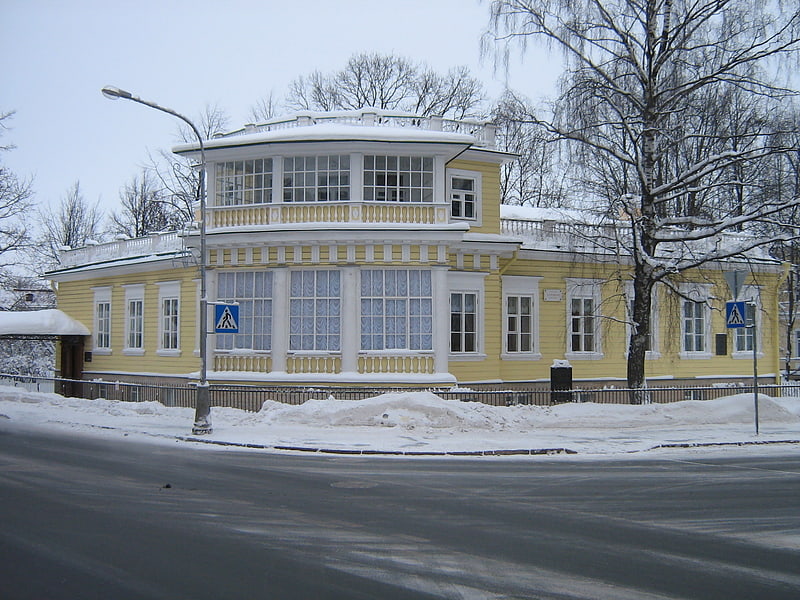
Building in Saint Petersburg, Russia. Kitaev's House is a building of the historical significance in Pushkin, Saint Petersburg. It was built in 1827, and has since been registered as a cultural heritage object. The building is located on 2/19 Pushkinskaya Street.[19]
Malushev's House
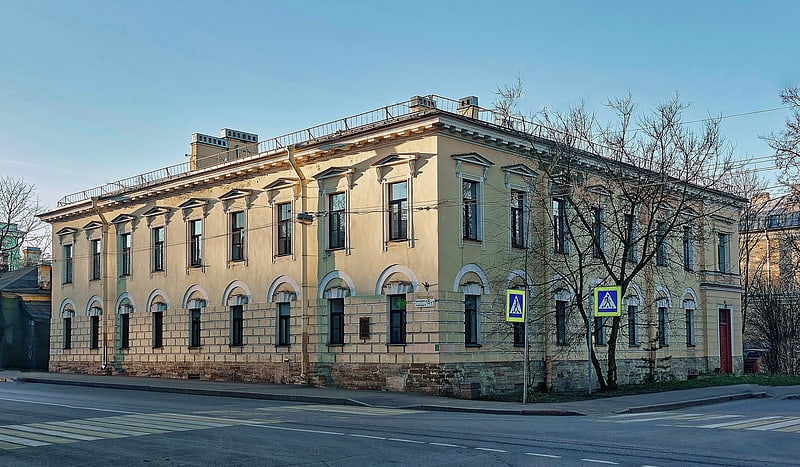
Building. Malushev's House is a building of the historical significance in Pushkin, Saint Petersburg. It was built in the period of 1822-1825. Nowadays it is an object of cultural heritage. The building is located on 17/16 Oranzherejnaya Street, and faces Sobornaya Square.[20]